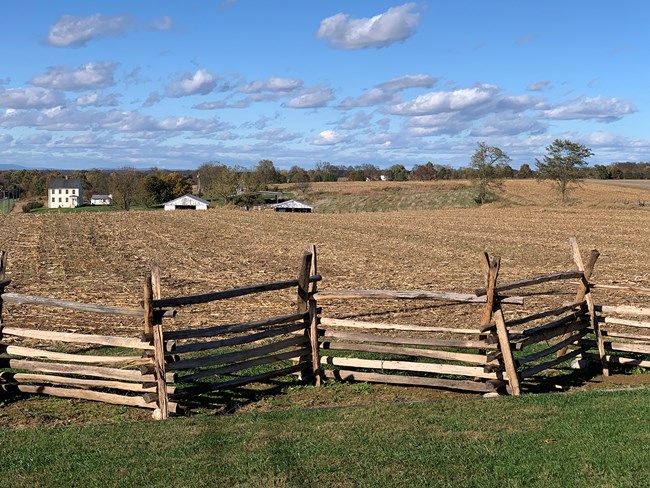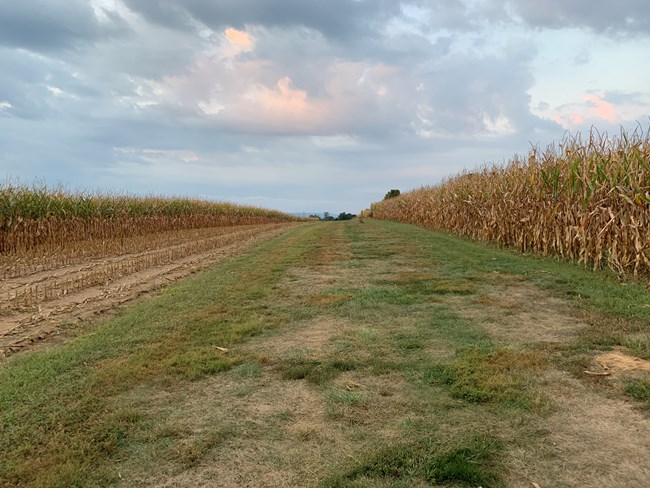
The Miller Farm and FamilyThe Millers enjoyed a prosperous and quiet life in Western Maryland, until their farm became entangled in the bloodiest one day battle in American history.Establishment of the PropertyWhat would become known as the D.R. Miller farm was first established by Christopher Cruss in the 1780s, and he lived there until about 1800 before he sold it to John Myers. It was around this time that the farmhouse and barn were first built, possibly by John Myers. In 1844, John Miller purchased the farm after John Myers’ death. John invested in property all around Sharpsburg and allowed his children to live in many of the homes. John decided to let his son David R. Miller, his wife Margaret, and their six children move onto this tract north of Sharpsburg. When D.R. moved in, the home was an ell shaped vernacular-style house, meaning construction was influenced by access to materials and the needs and building traditions of the local area more than a specific style. In addition to the main home, there were two tenant houses, a blacksmith shop, an out-kitchen, and several other structures on the property. The Hagerstown Turnpike, a main road connecting Sharpsburg to Hagerstown, was completed in 1810. The pike cut through the middle of the Miller property and separated the home from the barn, stable, corncrib, and hog pen. This wide turnpike, that was built and maintained through tolls, was ideal for both armies to easily move soldiers marching in column during the Maryland Campaign, and unfortunately it would lead huge numbers of Union and Confederate soldiers to the Millers’ front door. Once the Millers realized that the war was on their doorstep, they left their home to stay with his father in Sharpsburg. 
NPS Antietam Staff/ B.Baracz The Bloodiest Fighting on the Bloodiest DayOn September 17, 1862, the fighting began at daybreak, when the Union Army’s First Corps moved south from the area of Joseph Poffenberger’s farm. The Union troops passed by the Miller residence on their way south, but were halted when they encountered Confederate troops waiting for them in the Miller’s cornfield. An intense infantry battle followed. Soldiers in the Cornfield faced artillery fire from all directions. After approximately two hours of back and forth fighting, General Robert E. Lee sent reinforcements to aid Confederate General Thomas “Stonewall” Jackson’s exhausted troops in the Cornfield. The Confederate reinforcements pushed the Union troops back to the northern edge of the Cornfield, but then the Union Twelfth Corps arrived on the field and counterattacked. Around nine in the morning, the fighting slowed. Thousands of bullets and lives were spent in the attempt to gain control over D.R. Miller’s cornfield. In four hours of combat, almost eight thousand Union and Confederate soldiers had been killed or wounded in the area of the Cornfield. After this day, Miller’s field was simply referred to as “The Cornfield” due to the horrendous fighting that occurred there. As the day progressed, the fighting moved south closer to Sharpsburg where the Miller family had fled to the safety of D.R.’s father’s home. During this time, David Miller realized that the family’s pet parrot Polly was still in her cage hanging from the porch when the family had gone inside to shelter. Even with shells bursting around him, Miller dashed across the porch to rescue the beloved pet. However, before he could reach the bird, the leather strap that tethered her cage to the ceiling was severed by a shell fragment, sending Polly crashing to the ground. The story that D.R. Miller told was that he heard the bird cry, “Oh poor Polly!” as it fell. Luckily, both Polly and David made it safely back into his father’s house. 
NPS Antietam Staff/ B.Baracz “Every Stalk of Corn was…Cut as Closely as Could Have Been Done with a Knife”Upon their return home, the Millers were greeted with a gut-wrenching sight. It was evident that their home had been the center of some of the Civil War’s most ferocious fighting. Miraculously, the home and barn were relatively unscathed, and only the blacksmith shop was destroyed. However, the Miller’s crops were decimated by the savage fighting that had taken place. Union General Joseph Hooker recalled the scene that played on the Miller’s farm, saying that, “every stalk of corn in the northern and greater part of the field was cut as closely as could have been done with a knife, and the slain lay in rows precisely as they stood in their ranks a few moments before. It was never my fortune to witness a more bloody, dismal battlefield.” When the Millers returned they saw the food stored in the barn that had been previously harvested being distributed to the Union soldiers and to the wounded still on the field. The wounded from the Miller farm were quickly moved a quarter mile north to a field hospital. For days after the battle, Union burial details buried their comrades in graves near where they fell. Once the Union dead were interred, they also buried the Confederate dead. Miller’s farm fields were ideal for burials: the soft soils of farmed land made the gruesome task much easier compared to the untilled earth and so many had fallen in this small parcel of land. This made farming his fields very difficult for Miller in the several years following the battle. It took five years for the National Cemetery to be established for the reinterment of the Union soldiers, and then another two to five years for the reinterment of Confederate soldiers in three local cemeteries. Despite the best efforts of soldiers and locals to track where roughly 5,000 men had been buried in the fields, it was impossible to locate everyone. 1862 to Present DayThe Millers continued to live on the farm for the next twenty years. When his father, John Miller, died in 1882 he left a large amount of property to his eight children. However, he left no recorded will that dictated how his estate should be split among them. Unfortunately, his siblings would fight over D.R. Miller’s property, which he had lived on for almost forty years. A bitter court battle ensued, which lead to the sale of the property; the revenue was then divided amongst all of John’s children. In 1883, D.R. and Margaret Miller purchased the farm, but they sold it a little over two years later to someone outside of the family, Euromus Hoffman. A couple of years later, Margaret died on November 13, 1888. David died in September of 1893. The home stayed in the Hoffman family until 1933. The property changed hands several times, until in 1989 the farm was sold to the Conservation Fund. A year later, the Fund donated the property to the National Park Service. The home has been restored its 1862 appearance and is being persevered to ensure future generations have the opportunity to learn about the Millers. The fields are leased out each year to local farmers to raise crops and livestock. Even though the Cornfield is not always planted with corn for the health of the soil, the living farm program is important for preserving the agricultural landscape and history of the battlefield. Antietam National Battlefield is still one large cemetery. In 2008, a hiker in the park discovered a ground hog hole in the Cornfield with bones in it and alerted park staff. An archeological dig revealed bones, clothing scraps, a belt buckle, and brass buttons with the New York insignia. Upon examination of the bones, it was determined that the soldier was roughly seventeen to nineteen years old. The young man was returned home to New York, and was buried in Saratoga National Cemetery with full military honors on September 17, 2009, one hundred and forty-seven years after he gave the ultimate sacrifice in the Miller Cornfield. 
NPS Antietam/ K.Snyder |
Last updated: September 15, 2023
